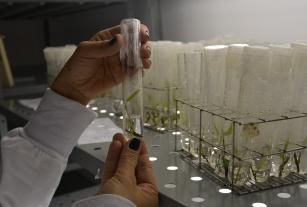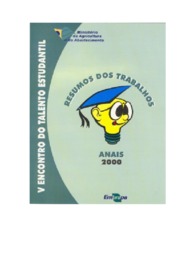Embrapa invests in varied methods of preserving industrial species to ensure the integrity of the conserved genetic material
Embrapa invests in varied methods of preserving industrial species to ensure the integrity of the conserved genetic material

Photo: GONÇALVES, Diva da Conceição
Agribusiness is one of the pillars of the Brazilian economy and a considerable part of the trade surplus achieved in recent years is due to exports of agricultural products . The product list is quite long , but some species are characterized by high demand and high production , such as soybeans , coffee and cane sugar.
The high output is due largely to the use of superior genotypes resulting from genetic improvement . Genetic improvement is an activity that must be performed continuously since the demand for new genotypes is also constant due to different reasons , eg , migration of pests and diseases and expanding cultivation into new areas , such as the cane sugar whose expansion area presents serious water stress , demanding tolerant genotypes that kind of stress .
So that the demands are met , ie , that new genotypes with desired characteristics are obtained, it is vital that alleles involved in the expression of traits of interest are available in the gene pools of cultivated species . The availability of these alleles depends on adequate conservation of germplasm available.
The conservation of germplasm of species of major importance for the Brazilian industry , such as coffee, cocoa, sugar cane , palm oil and rubber , for different reasons ( recalcitrant seeds , need to retain certain highly heterozygous genotypes ) , has been performed in order to ex situ plants maintained in the field . This type of conservation presents some disadvantages such as high maintenance cost , because for some species occupied area is considerable, in addition to being subject to the risk of loss or part of the collection by attack of pests , diseases or due to inclement weather .
This project aims to develop technologies and methodologies that enable better conservation knowledge of these collections and thus identify more appropriate management practices for the sake of their maintenance and enrichment. One of the expected benefits is cost reduction by reducing the number of individuals through the identification and elimination of duplicates , create collections - core and introduction of not existing accesses .
Better knowledge of the collections also contribute to the direction of the characterization of the accessions process because of the determination of the degree of characterization studies may be targeted and prioritized more effectively to fill the gaps , thus increasing the usefulness of these collections in breeding species as important to the national economy .
This project aims to invest in conservation methods , such as maintenance in vitro or cryopreservation , to support ex situ conservation of the field , to ensure the integrity of all genotypes of the collections . The conservation in vitro can be used both for recalcitrant plants having seeds as highly heterozygous for those whose segregation is undesirable , as is the case of cane sugar. Already cryopreservation is a method that can be used to seed intermediate behavior , such as coffee , or recalcitrant . Both allow for the preservation of duplicates of collections maintained in the field , ensuring the conservation of all available genotypes .
The high output is due largely to the use of superior genotypes resulting from genetic improvement . Genetic improvement is an activity that must be performed continuously since the demand for new genotypes is also constant due to different reasons , eg , migration of pests and diseases and expanding cultivation into new areas , such as the cane sugar whose expansion area presents serious water stress , demanding tolerant genotypes that kind of stress .
So that the demands are met , ie , that new genotypes with desired characteristics are obtained, it is vital that alleles involved in the expression of traits of interest are available in the gene pools of cultivated species . The availability of these alleles depends on adequate conservation of germplasm available.
The conservation of germplasm of species of major importance for the Brazilian industry , such as coffee, cocoa, sugar cane , palm oil and rubber , for different reasons ( recalcitrant seeds , need to retain certain highly heterozygous genotypes ) , has been performed in order to ex situ plants maintained in the field . This type of conservation presents some disadvantages such as high maintenance cost , because for some species occupied area is considerable, in addition to being subject to the risk of loss or part of the collection by attack of pests , diseases or due to inclement weather .
This project aims to develop technologies and methodologies that enable better conservation knowledge of these collections and thus identify more appropriate management practices for the sake of their maintenance and enrichment. One of the expected benefits is cost reduction by reducing the number of individuals through the identification and elimination of duplicates , create collections - core and introduction of not existing accesses .
Better knowledge of the collections also contribute to the direction of the characterization of the accessions process because of the determination of the degree of characterization studies may be targeted and prioritized more effectively to fill the gaps , thus increasing the usefulness of these collections in breeding species as important to the national economy .
This project aims to invest in conservation methods , such as maintenance in vitro or cryopreservation , to support ex situ conservation of the field , to ensure the integrity of all genotypes of the collections . The conservation in vitro can be used both for recalcitrant plants having seeds as highly heterozygous for those whose segregation is undesirable , as is the case of cane sugar. Already cryopreservation is a method that can be used to seed intermediate behavior , such as coffee , or recalcitrant . Both allow for the preservation of duplicates of collections maintained in the field , ensuring the conservation of all available genotypes .
Ecosystem: Amazonic, Atlantic Forest, Cerrados Region
Status: Completed Start date: Thu Jan 01 00:00:00 GMT-03:00 2009 Conclusion date: Thu Dec 31 00:00:00 GMT-03:00 2015
Head Unit: Embrapa Genetic Resources & Biotechnology
Project leader: Marcos Aparecido Gimenes
Contact: marcos.gimenes@embrapa.br
Keywords: cacau, café, cana-de-açúcar, dendê, guaraná, seringueira


